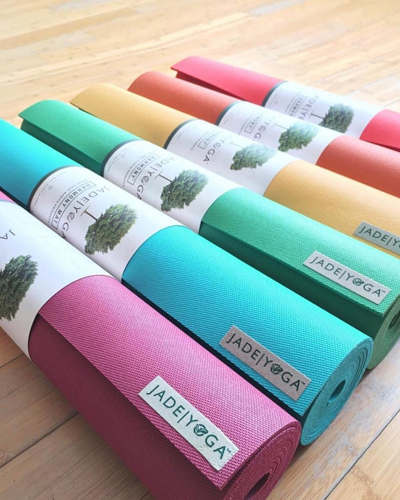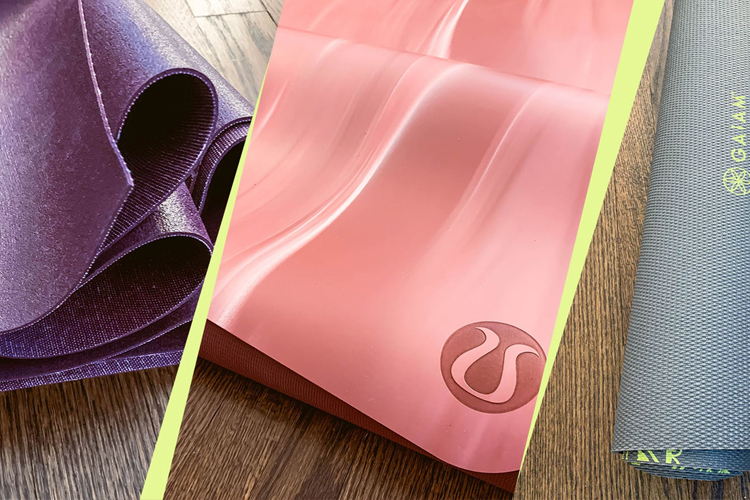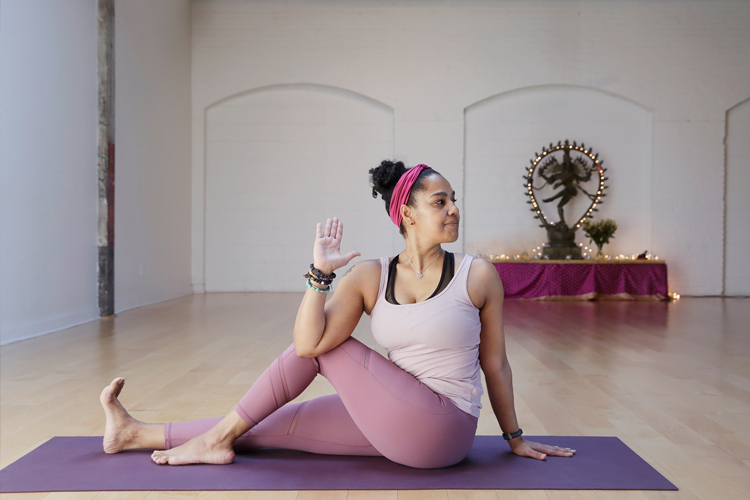In yoga, everything is about mat. No matter if you are a beginner yogi or experienced one, yoga school attendant or you practice at home, the mat will be the attribute that you need. Taking into account recent events it became rather a necessity to have your own mat to keep the right hygiene and safety.
If you start looking for a yoga mat on the internet you will find out that there are so many types of mats on the market that you can easily get confused. There are different materials, thicknesses, colors and textures that’s it’s easy to get discouraged in your search.
Here you can find the complete guide that will help you to choose the best yoga mat for your practice.
First you need to define what the purpose is of having your mat. No matter if the mat would be used only for after-work out stretching or you want to practice hot yoga, the mat definitely needs to suit you. Choosing the right mat according to its material, size, weight and size will benefit your practice. We will focus first on material, later on cushioning, size, weight, level of advancement and style of your practice.
Materials which the mats are made from:

PVC
For long time the most popular mats were those made from PVC (polyvinyl chloride), because usually they were and are the cheapest). Nowadays more and more people (yogis especially) are looking for sustainability and pro-ecological solutions. That means that PVC mats will inevitably be dethroned.
PVC is a plastic. It can be made softer and more flexible (as yoga mats are) by the addition of plasticizers, the most widely used being phthalates. PVC is known also as vinyl, the most toxic plastic. PVC is considered to be toxic during every stage of its life cycle. It is toxic during its manufacture, it is toxic to the end consumers, toxic during its disposal. As consumers we are exposed to PVC through inhalation and skin contact. This material is not eco-friendly and biodegradable. It also cannot be recycled. If you want to buy such a mat be sure the mat will have OekoTex safety certificates. Those mats are considered as safe but still PVC is not biodegradable. The only way to get rid of it is to burn it and during the burning process, the chlorine produces extremely toxic and persistent dioxins that end up in soil, fish, animals, water, air and ultimately in our bodies.
PVC mats serve well for fitness, pilates or other gym activities. They are not recommended for intense yoga practice as they do not absorb moisture and can get very slippery.
TPE
TPE (Thermoplastic elastomers) is a physical mix of polymers (usually plastic and rubber). It is a new, more and more popular material for mats production. The main advantage of it is its weight, even the thick TPE mats are light and easy to transport. Mats made from TPE do not lose their shape and are eco-friendly – they can be recycled. Material is anti-microbial, which means it does not allow bacteria to grow, are recommended for allergy sufferers as the structure of the cells prevents absorption of dirt and sweat.
TPE is quite soft material (not dense and compact as PVC) which for some people might be a disadvantage as they prefer harder materials, for others it might be advantage as the mat can be easily used for pilates. The anti-slip properties of PVC mats are considered to be good but TPE is not very sticky to the floor, which might make your practice unstable.

Natural Rubber
Natural rubber is natural material and for many that fact is already an advantage. However, what attracts yogis the most is its anti-slip properties. In this respect rubber mats are number one on the market and thanks to it will make your practice very stable.
Rubber has also specific smell that for some it is neutral, for some it is disturbing. That smell fades over time. If you want to get rid of the rubber smell faster do not roll up mat, leave it unfolded for a while. This will speed up the odor evaporation process.
Natural rubber is a heavy material that for sure will keep your mat in the same place during your practice.
People with rubber or latex allergies should avoid contact with this mat as it contains dry natural rubber and may contain latex.
Nowadays the most trending materials for yoga mats are base from natural rubber which can be covered with microfiber (suede), PU leather or cork on top. Those kinds of mats are adored by yoga practitioners due to its moisture absorbency, exceptional grip, durability and eco-friendliness. The natural rubber bottom makes them biodegradable and free from harmful chemicals. The bottom layer from natural rubber guarantees high adhesion to the substrate. Thanks to this, the mat does not slip, even with dynamic practice.
In many ways those mats are considered the best option, however they might be heavy.
Microfiber (Suede)
The popularity of this material for yoga mats has been growing significantly in recent years. Microfiber with natural rubber on the underside do not slide across the floor during practice. Top, made from microfiber is a replacement for a yoga towel, which is made of the same material. Both, a yoga towel and a yoga mat covered with microfiber have their purpose – to absorb the moisture and sweat. That is why it’s often called 2in1 mat. When we sweat ordinary mats, even those from rubber, are unable to cope with the slippery layer of sweat that forms on surface. Microfiber absorbs sweat and the wetter the surface is the more anti-slip properties it has and gives you better grip. If you are not warmed up enough it is often recommended to slightly moisten the hands and feet or sprinkle water on the mat where the feet and hands are placed at the beginning of the practice to activate the non-slip properties of the mat.
This material is recommended for hot yoga practice, to achieve smooth movements or for those who want to get deeper muscle engagement. Due to the limitations of microfiber, this material is not recommended for static yoga styles.
The care of microfiber mats is simple – by just wiping them with a cloth or sponge with a light detergent.

PU (polyurethane)
PU is used to cover the top layer of natural rubber mat (however, middle and bottom part can also be made from PVC). Polyurethane is very pleasant in touch, often very smooth. Lack of roughness of the surface doesn’t mean low anti-slip properties. PU gives excellent grip from the first moments of your practice, you can feel confident on your mat, hands and feet will not slip – both during quiet and intensive practice.
PU is also quite delicate material, prone to scratches. It is good to take care of the PU mat and keep it in a cover so that you will not damage the surface of the mat. While using this kind of mats you should avoid using hand cream before your practice and keep it away from oil and grease. Also, when caring for the mat, you should avoid using alcohol-based detergents. Such substances can destroy the PU.
Polyurethane strongly absorbs moisture, so slight discoloration may appear on the surface over time. They have no influence on the functionality of the mat.
Mats with PU top layer have a typical smell for few days after the purchase.
Cork
Cork tops are getting more and more popular. First of all it is natural material derived from the bark of cork oak tree, which is a renewable resource. Gaining the raw material does not disturb the balance of natural environment in any way, because cork forests regenerate spontaneously. The layer of cork on yoga mats has antibacterial and antistatic properties. That means it does not retain bacteria and dust, so it can be safely used by allergy sufferers. Due to ability to be naturally resistant to microbial growth, cork is considered anti-microbial.
Cork does not absorb moisture, but thanks to oily suberin present in its structure, it is sufficiently adhesive. The anti-slip properties are similar as with microfiber mats (they increase with the increasing amount of moisture on the mat). That is why it is perfect for dynamic yoga practices.
Easy to clean, after practice it is enough to wipe it with a damp cloth to get rid of dirt from the mat surface.
Process of abrasion and crumbling of the cork is normal. The lifespan of natural resources has its limit, however by choosing this material you take care of our planet. That is why cork seems to be a perfect choice for those who are concerned about environment and like to surround themselves with natural products.
Jute
Jute is a natural fibre from a plant. It is eco-friendly material. Jute yoga mats often have one side of jute and the other side of PVC or PER. PER stands for Polymer Environmentally Friendly Resin, which is friendlier than PVC and less damaging to the environment.
These kinds of mats are considered to be half-recyclable (The jute part is while the PER part is not). Mats are usually lightweight, easy to carry and suitable for travel. The natural fibers can be a bit course to the skin and mats can be too hard for the joints. They don’t provide a firm grip and are rather recommended for more static and calm yoga types.
Cotton
Organically produced cotton is eco-friendly material. The production does not use pesticides, chemical fertilizers and relies on rainfall. These mats are fully biodegradable, sustainable, has a great grip, absorb the sweat. They are recommended for all types of yoga. Cotton mats might be a bit coarse to the skin and less cushioning.
Thickness – cushioning
On the market you can find mats from 1mm to 8 mm thick. The rule is simple- the thicker the mat is, the better cushioning of joints and bones (your wrists and knee joints).
1-2 mm thickness:
Thin mats, considered as travel mats. They work well because they give a sense of stability and non-slip properties like standard mats but they weigh less and take up much less space. They are not recommended for daily practice and it’s good idea to put a blanket or towel under your knees while doing kneeling positions.
3-4 mm thickness:
Standard thickness of mats, most of mats on the market oscillate within these limits. They provide reasonable cushioning but it is still advised to put an additional layer under knees.
5-8 mm thickness:
Thick mats are for the best shock absorption. With them you feel solid insulation from the ground. Good thickness for intense and dynamic yoga styles.
Size and weight
The size of a yoga mat varies between 170-180 cm (67-71 in) in length and 60-70 cm (24-28 in) in width. You can find other sizes too, but the only thing that should be considered when choosing the mat is your height. You should feel comfortable lying down in savasana on your yoga mat.
Style and design
The design of the mat is a very personal preference, however there are common techniques to apply design to all mats. To cut the mat in its final shape often laser-cutting technology is used which ensures the mat to keep its grip and provide a longer lasting quality. The microfiber top layers are colored with water-based ink, which is a very safe technique that does not affect the characteristics of the mat and is very durable. Other techniques where the colors and patterns are applied by paint will not give the same quality and may erode in the course of time. Moreover, the grip of a painted mat is much less and can even be slippery.
Cost
Different people have different budgets for the purchase of a yoga mat. You will find that the prices of various brands of yoga mats in stores and web shops may vary from below €10 up to prices more than €100 per mat. De difference lies in the materials used and the size of the mat. We believe that even if you are a beginner yogi, the purchase of a more expensive, high-quality mat is always the best choice. Do not let a poor mat stand in your way to enjoy any yoga pose. Scroll up where we explain you the characteristics of the different materials. As personal as a yoga mat is, also ask other yogi why they choose a particular brand, material or mat size. You can also drop us an email at hello@niumeyoga.com and we are happy to share our personal experience too. A good mat is literally the basis for comfortable, stable and pleasant yoga practice. So do your research and then make your best choice.

